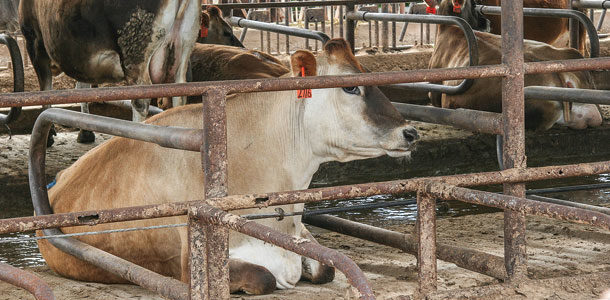The increased milk production possible with modern dairy cows helps shine the spotlight on the role of essential amino acids in herd production and performance. The production benefits for monogastrics have made amino acid nutrition a staple of pork and poultry production for decades.
Balancing for amino acids, an increasingly routine part of ration formulation, typically delivers the best results in well-managed herds. Herd management for optimal production and performance directly impacts each herd’s success in reaching its full potential.
Management tools are evolving. Several rumen-protected amino acid products are available today for use in dairy rations. Ration formulation software continues to evolve and continues to streamline the amino acid-balancing process. In addition, insights into herd management continue to be identified.
The world’s top milk-producing cow produced 72,170 pounds of milk with 2,787 pounds of butterfat and 2,142 pounds of protein in one year. What is holding the rest of our cows back? What prevents them from reaching those levels every year?
As cows go through the phases of lactation, several key management issues influence whether or not they will reach their peak genetic potential. Time spent on management pays a return on the investment.
Dry period
The dry period is “vacation time” for hard-working cows – but not for dry cow managers. While the dry period is not a strenuous time for cows, your herd management at this time can set the cows up for success or failure during the next lactation.
A key management strategy is to make sure cows do not gain condition. Cows gain weight as the fetus grows, but increases in condition set dry cows up for metabolic diseases such as fatty liver.
In the dairy industry, research is exploring the role of amino acid balancing in dry cows. For instance, arginine could potentially be a limiting amino acid in pre-fresh cows. If so, arginine may have the potential to increase the presence of a key regulator in protein synthesis and cell proliferation, known as mTOR, in the unborn calf. If so, the calf may be more genetically inclined to produce a higher percent of milk protein when it enters the milking herd.
Pre-fresh
This could potentially be the most important time in the cow’s entire lactation. Critical management steps include reducing pen moves. Every time a cow meets a new cow, she can lose up to 8 pounds of potential milk production.
In addition, cows should be kept in this group for 21 days pre-calving. This gives each cow time to adapt to the diet in a two-group dry period, as well as adapt to the pen and other animals.
Also imperative is ample space; do not overcrowd the cows. Research indicates that stocking density rates as low as 80 percent may be ideal for each cow to reach her full potential.
Amino acid balancing plays a key role too. In a New York trial, cows were either fed a control diet or a diet supplemented with amino acids. Cows fed the diet supplemented with amino acids produced more milk, consumed more feed and, overall, had better transitions to lactation.
Fresh cow
After successfully calving, cows undergo many changes, including the type of diet they consume, where they are housed and their level of general stress as they begin lactation.
During this time, just as with pre-fresh cows, give the cows ample space – avoid overcrowding. In addition, provide ample bunk space so cows can eat when they want. Facility considerations include making sure stalls are designed for maximum cow comfort and providing ample water space.
Research has shown that cows will not give up lying-down time to eat. When stall spaces are limited, animals will choose to lie down. They will forfeit bunk time. For every 3.5 minutes of rest gained, a cow will sacrifice one minute eating at the bunk.
Feed push-up and position is important. Cows naturally have aggressive feeding behavior. They can force more than 500 pounds of pressure against a feed barrier to reach their feed. If you make them work, they may make you work.
Amino acid balancing is most important during the fresh cow phase in the lactation cycle. Even at its best, when everything is going correctly, cows experience low feed intakes and negative energy balance. Synthetic rumen-protected amino acids provide a concentrated nutrient source when most needed.
High group
While in the high group, cows produce their largest amounts of milk. The impact of good herd management may be most visible, as seen in the milk tank. Key management factors continue to play a role. Make sure your cows are stress-free to make sure milk production is not compromised. Good cow managers insist on proper stall design, stocking density, feed push-up practices and time in the holding pen.
In a trial published in the Journal of Dairy Science in 2008, 47 herds in Spain were fed the same TMR. Herd production ranged from 45 to 74 pounds of milk per day. Therefore, non-dietary factors accounted for 56 percent of the variation in milk yield. If each herd’s ration was properly balanced for amino acids, the range of milk production might be eye-opening.
In the high group, amino acid balancing can allow cows to produce closer to their genetic potential. As milk yield increases, so too can the total butterfat and protein produced. Gut fill from forages will likely limit feed intake. Supplying nutrients in a concentrated form may help your cows better meet their nutritional needs.
Low group
Some dairies have a low [production] group. These cows are at the end of their lactation and are about to go dry. Their diet typically contains fewer additives, costs less and relies heavily on forages.
Typically, cows go down in production when they enter this group. Good management continues to call for stall comfort, fresh feed that is readily pushed up and ample water space.
Amino acid balancing plays a role. As an industry, we have yet to learn the effects of nutrigenomics in amino acid nutrition.
Nutrigenomics is research that focuses on identifying and understanding molecular-level interaction between nutrients and other dietary bioactives, such as trans10, cis12-conjugated linoleic acid, with the genome. We know this long-chain fatty acid can turn off the regulators for milkfat synthesis. In the future, we may have the potential to completely change production potential by what is fed to cows during pregnancy.
Summary
Attention continues to be focused on how dairy rations can promote greater herd production and performance as well as cow health. From the longer-term experiences of our monogastric colleagues with pigs and poultry, we know that rations properly balanced for amino acids most definitely affect production and performance.
The greatest results, though, require a team effort between dairy nutritionists and herd management. With proper herd management, a higher return on investment in feed is typically realized. The best herd managers actively minimize barriers to production and performance. These managers strive for the best environment and care possible for their herds. PD
PHOTO: Research has shown that cows will not give up lying-down time to eat. When stall spaces are limited, animals will choose to lie down. They will forfeit bunk time. For every 3.5 minutes of rest gained, a cow will sacrifice one minute eating at the bunk. Staff photo.

-
Jessica Tekippe
- Product Manager
- Ajinomoto Heartland Inc.
- Email Jessica Tekippe






